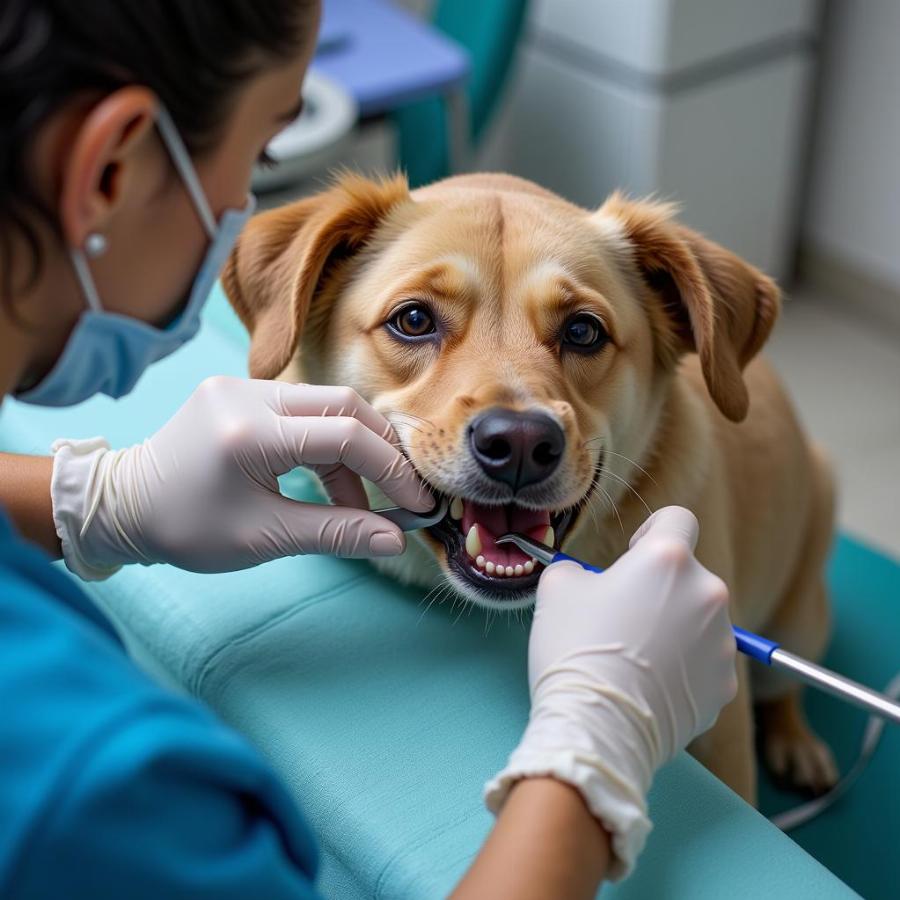Gingival hyperplasia in dogs, while sounding complex, simply refers to an overgrowth of the gums. This overgrowth, while it might seem like a minor issue, can lead to significant discomfort and even health problems for your furry friend. This article will delve into the causes, symptoms, and treatment options for gingival hyperplasia, equipping you with the knowledge to keep your dog’s mouth healthy.
What Causes Gingival Hyperplasia in Dogs?
There are a few key culprits behind this gum issue:
- Genetics: Some breeds are simply predisposed to gingival hyperplasia. These include Boxers, Bulldogs, Great Danes, and Doberman Pinschers. If you have one of these breeds, be extra vigilant about their dental hygiene.
- Medications: Certain medications, like those used to suppress the immune system or control seizures, can sometimes have gingival hyperplasia as a side effect.
- Poor Dental Hygiene: Just like in humans, plaque and tartar buildup can irritate a dog’s gums, leading to overgrowth.
- Inflammation: Chronic inflammation in the mouth, often caused by periodontal disease, can trigger gingival hyperplasia.
Recognizing the Signs of Gingival Hyperplasia
Early detection is key. Here’s what to watch for in your dog’s mouth:
- Swollen Gums: The gums will appear puffy and red, extending further than normal over the teeth.
- Bleeding Gums: You may notice blood on your dog’s chew toys or when you brush their teeth.
- Bad Breath: An increase in bad breath can be a sign of gum issues, including hyperplasia.
- Difficulty Eating: Overgrown gums can make chewing painful, leading to a decrease in appetite or difficulty picking up food.
Diagnosis and Treatment Options
If you notice any of the above signs, a trip to the veterinarian is in order. Your vet will examine your dog’s mouth and may recommend dental X-rays to assess the severity and rule out other dental problems.
Treatment for gingival hyperplasia will depend on the underlying cause and the severity of the overgrowth:
- Professional Dental Cleaning: A thorough cleaning under anesthesia is often the first step. This removes plaque and tartar, reducing irritation.
- Medication: If your vet suspects a medication is the cause, they may adjust the dosage or switch to a different drug.
- Gingivectomy: In severe cases, surgical removal of the excess gum tissue may be necessary. This allows the gums to heal properly and prevents future problems.
 Dog Undergoing Dental Surgery
Dog Undergoing Dental Surgery
Preventing Gingival Hyperplasia in Dogs
Prevention is always better than cure! Here’s how to keep your dog’s gums healthy:
- Regular Brushing: Aim to brush your dog’s teeth daily using a toothpaste specifically designed for canines.
- Dental Chews and Toys: Provide your furry friend with dental chews and toys that help scrape away plaque.
- Regular Veterinary Dental Check-ups: Just like humans, dogs benefit from professional dental cleanings. Ask your veterinarian how often your dog needs this.
- Diet: A balanced diet contributes to overall health, including oral health.
Living with Gingival Hyperplasia
If your dog has been diagnosed with gingival hyperplasia, don’t despair. With proper care and management, your dog can still live a happy and comfortable life.
- Follow Your Vet’s Recommendations: Be diligent about following your veterinarian’s instructions regarding medications, dental cleanings, and follow-up appointments.
- Monitor Their Mouth: Regularly check your dog’s mouth for any changes or signs of recurrence.
- Provide a Healthy Lifestyle: A nutritious diet, regular exercise, and a stress-free environment all contribute to your dog’s overall well-being, including their oral health.
When to Seek Veterinary Attention
While this article provides general information, remember that every dog is different. If you notice any changes in your dog’s gums, or if they show signs of oral discomfort, contact your veterinarian immediately. Early intervention is crucial for managing gingival hyperplasia and ensuring your furry friend maintains a healthy, happy smile.
FAQs About Gingival Hyperplasia in Dogs
Q: Is gingival hyperplasia painful for dogs?
A: Yes, in many cases, gingival hyperplasia can be painful for dogs, especially as the condition progresses. The overgrown gums can easily become inflamed and irritated, making chewing and even closing their mouths uncomfortable.
Q: Can gingival hyperplasia go away on its own?
A: Unfortunately, gingival hyperplasia typically doesn’t resolve on its own. It usually requires veterinary intervention to manage the overgrowth and address the underlying cause.
Looking for More Information on Dog Health?
About Beaut Dogs
Beaut Dogs is your trusted companion in the world of canine care. We’re here to provide you with the knowledge and resources you need to ensure your dog lives a healthy, happy life. When you need expert advice, reach out to us at [email protected].